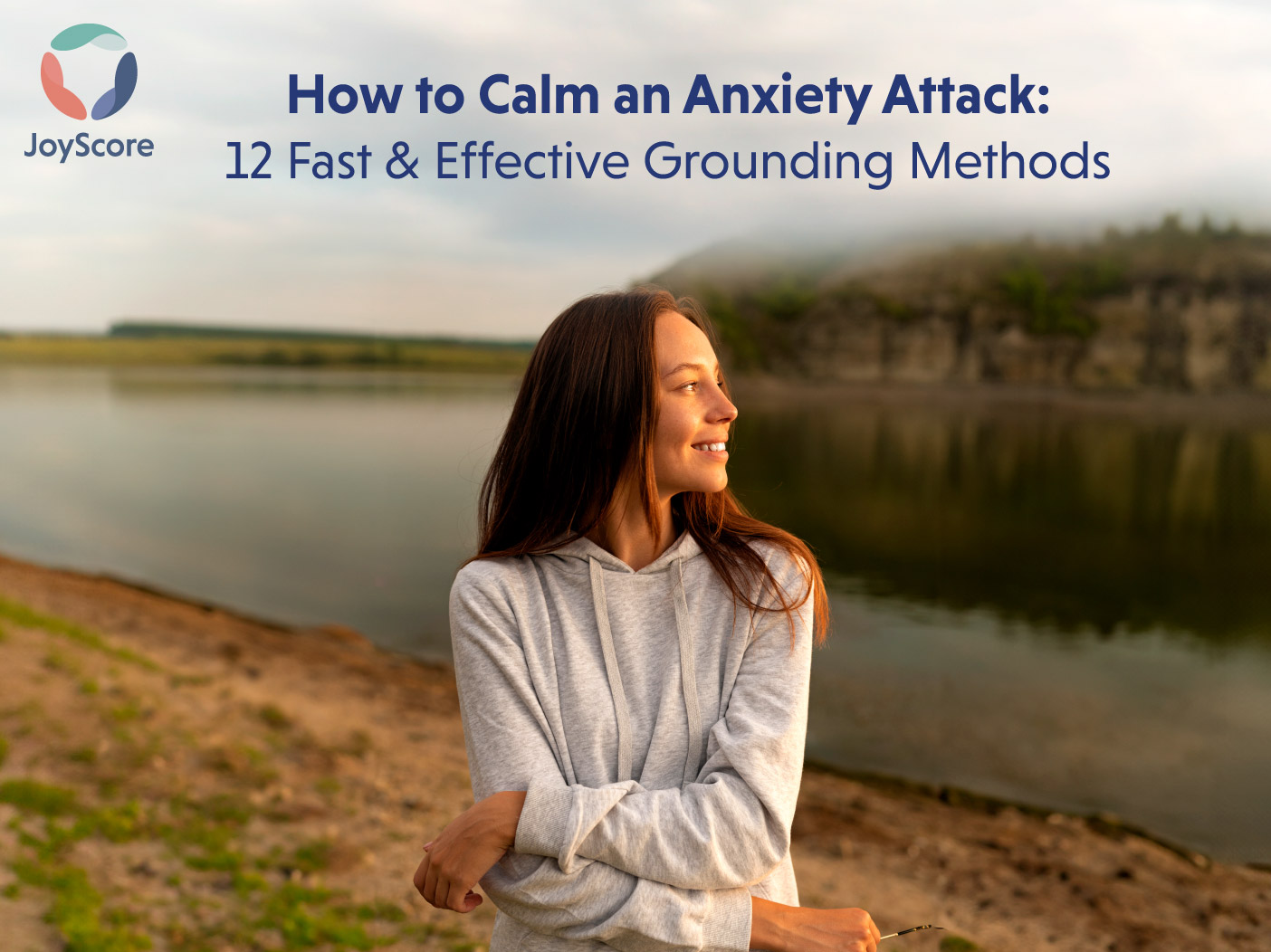In today’s fast-paced world, anxiety is common among the majority of individuals. With pressure from work, social obligations, and digital connectivity, anxiety attacks are on the rise. According to the Anxiety and Depression Association of America,the majority of adults in the U.S. have anxiety disorders, making it the most common mental health condition in the country. Let’s begin by understanding what an anxiety attack is and then we’ll dive into how to calm it efficiently.
What’s Anxiety
An anxiety attack, often referred to as a panic attack, is a sudden onset of intense fear or discomfort that peaks within minutes. It can be overwhelming and can significantly interfere with daily activities. While “anxiety attack” and “panic attack” are sometimes used interchangeably, they can refer to different experiences. Anxiety attacks are typically linked to a build-up of anxiety over time, while panic attacks often occur suddenly without an obvious trigger.
The symptoms of an anxiety attack can vary from person to person but generally include a combination of physical and emotional signs. Here are some common symptoms:
- Rapid Heartbeat
- Shortness of Breath
- Chest Pain
- Dizziness or Lightheadedness
- Sweating
- Trembling or Shaking
- Hot Flashes or Chills
- Nausea or Abdominal Distress
- Numbness or Tingling
- Feelings of Unreality or Detachment from Oneself
- Fear of Losing Control or “Going Crazy”
- Fear of Dying
Anxiety: Disorder or Disease
Anxiety is a mental health disorder, not a disease. According to the American Psychiatric Association, it’s the most common mental health condition, which also includes GAD, panic disorder, social anxiety, and specific phobias.
How Anxiety Affects the Body and Mind
Anxiety can affect both your body and mind. It can cause an increased heart rate, muscle tension, digestive problems, and weaken your immune system. It can also mess with your memory and decision-making, making you worry constantly, have mood swings, and struggle with sleep. Socially, it often leads to avoiding people and impacting your relationships.
Understanding these effects shows why it’s important to manage anxiety for your overall health. Grounding techniques can help during anxiety attacks by focusing on the present moment, which calms you down. Using these techniques every day can give you quick relief and help keep your mental health steady over time.
Calming Anxiety: 12 Quick and Effective Grounding Techniques for Relief
Anxiety attacks can be intense and overwhelming, but several strategies can help manage and reduce their impact. In fact, anxiety attacks are highly treatable with a combination of approaches. Here are 12 of some of the most effective methods to beat anxiety attacks:
1. Deep Breathing Exercise: Controlled breathing can significantly reduce anxiety. Try these techniques:
- 4-7-8 Breathing: Inhale, hold and exhale for 4 seconds, 7 seconds and 8 seconds respectively. Repeat this four times
- Box Breathing: Inhale for 4 seconds, hold for 4 seconds, exhale for 4 seconds, hold for 4 seconds. Repeat for several cycles
- Diaphragmatic Breathing: Sit comfortably, place one hand on your chest and the other on your abdomen. Inhale deeply through your nose, letting your abdomen rise, then exhale slowly through your mouth.
- Alternate Nostril Breathing: Close your right nostril and inhale through your left, hold, then exhale through your right nostril. Switch sides and repeat
These exercises help calm the nervous system and manage anxiety effectively.
2. Grounding Technique 5-4-3-2-1 : This technique helps refocus your mind by identifying your surroundings: name 5 things you can see, 4 things you can touch, 3 things you can hear, 2 things you can smell, and 1 thing you can taste.
3. Grounding Statements: Repeat grounding statements to yourself, such as “I am safe right now” or “This feeling will pass.” This can reassure you and reduce panic.
4. Counting Backwards: Count backwards from 100 by threes. This requires concentration, which can divert your attention from the anxiety attack.
5. Cold Water Splash: Splash cold water on your face or hold an ice cube. The sudden cold sensation can interrupt your anxiety and bring you back to the present.
6. Listening to Music: Play soothing music to distract and calm yourself from racing thoughts. Focus on the melody, lyrics, or rhythm.
7. Writing or Drawing: Expressing your feelings by writing in a journal or drawing can help you process emotions and reduce anxiety.
8. Mindful Walking: Walking mindfully means paying close attention to each step and the sensations in your body as you move. Walk slowly, concentrating on the feeling of your feet touching the ground and the rhythm of your steps.
9. Visualization: Find a quiet place, close your eyes, calm down, and take deep breaths. Visualize a positive memory, focusing on the details and engaging all your senses. Allow the positive emotions to replace the anxiety. Stay with this memory for a few minutes.
10. Progressive Muscle Relaxation: This technique involves tensing and then relaxing each muscle group, which helps you focus on physical sensations and stay present. Onset from your toes and work your way up to your head, tensing each muscle group for a few seconds before releasing.
11. Seeking Professional Help: Consult a therapist or counselor for techniques like Cognitive Behavioral Therapy (CBT) to manage anxiety.
12. Using Apps
Use mental health apps like JoyScore, which offer personalized activities and recommendations to manage anxiety.
Using JoyScore for Anxiety Management
- Daily Check-Ins: Use the app to check in with your mood and activities daily, which helps in maintaining awareness of your mental state.
- Mindfulness and Relaxation: Engage in the app’s mindfulness and relaxation activities regularly to keep anxiety at bay.
- Feedback and Adjustments: Use the feedback from the app to adjust your activities and focus on what works best for you.
FAQs
- How long does an anxiety attack last?
Anxiety attacks typically last from a few minutes to over an hour, with peak intensity usually occurring within the first 10 minutes .
- What triggers anxiety attacks?
Common triggers include stress, health concerns, phobias, certain medications, caffeine, stimulant consumption, drug or alcohol withdrawal, and trauma .
- Can anxiety attacks be prevented?
While not completely preventable, anxiety attacks can be reduced through regular exercise, relaxation techniques, avoiding caffeine and alcohol, adequate sleep, therapy, and prescribed medication .
- What should I do during an anxiety attack?
Stay calm, practice deep breathing, use grounding techniques, repeat positive affirmations, find a safe space, and contact support .
- When should I seek professional help?
Seek help if anxiety attacks are frequent or severe, disrupt daily life, persist despite self-help efforts, or involve thoughts of self-harm or suicide.
Conclusion
Anxiety attacks are challenging, but grounding techniques can provide a quick relief and help your body learn how to prevent them in the future. Find what works for you and practice regularly. For persistent anxiety, seek professional help; therapists, counselors, and medication can offer support. Using these methods daily builds resilience and improves well-being. Remember, managing anxiety is a journey, seeking help is a good thing, and with the right tools and support, you can overcome it and lead a fulfilling life.
Download the app now from the App Store or Google Play.



